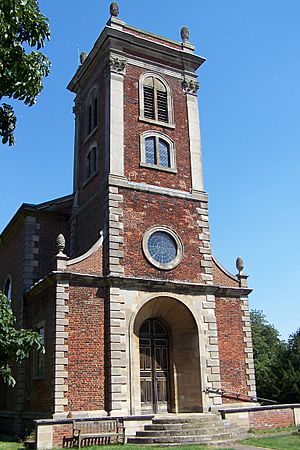Church of St Mary Magdalene, Willen facts for kids
Quick facts for kids Church of St Mary Magdalene, Willen |
|
|---|---|

Church of St Mary Magdalene, Willen
|
|
| 52°03′44″N 0°43′13″W / 52.06234°N 0.72015°W | |
| Location | Willen, Milton Keynes |
| Country | United Kingdom |
| Denomination | Church of England |
| Architecture | |
| Architect(s) | Robert Hooke |
| Style | English Baroque |
| Years built | 1680 |
| Administration | |
| Parish | Willen |
| Diocese | Diocese of Oxford |
The Church of St Mary Magdalene is a historic Church of England church in the village of Willen, which is now part of Milton Keynes in Buckinghamshire. It is named after Mary Magdalene, a follower of Jesus.
The church was designed by the famous scientist and architect Robert Hooke and was finished in 1680. Because of its special history and design, it is a Grade I listed building. This means it is considered a building of great national importance and must be protected.
History of the Church
The church you see today was built to replace an older, simpler one. The old church was similar to the one in the nearby village of Great Woolston, but it didn't have a small tower.
A New Church for Willen
The new church was paid for by Dr. Richard Busby. He was the headmaster of the famous Westminster School for a very long time. He was also the Lord of the Manor in Willen, which meant he owned the land and was an important figure in the village.
The architect chosen for the job was Robert Hooke, who had been one of Dr. Busby's students at Westminster School. Hooke was a brilliant scientist, inventor, and architect. He helped design the church and also watched over its construction, which took place between 1678 and 1680.
A Costly Project
Building the church was very expensive. Dr. Busby spent almost £5,000 on it. This large sum didn't even include the cost of materials that were reused from the old church building.
At the time, a writer named George Lipscomb commented that with better planning, the church could have been built for a third of the price.
Changes Over the Centuries
In the 1800s, the church was changed. A small dome, called a cupola, was removed from the top of the tower. At the same time, a rounded section called an apse was added to the end of the church's main hall, or nave.
These changes went against Robert Hooke's original idea. He had wanted a simple main building with a fancy, decorated tower. The changes in the 19th century did the opposite.
The church has kept records of local events, called parish registers, that go all the way back to 1665.

